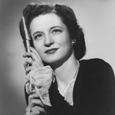
In 1928, a young flutist Frances Blaisdell wrote the Institute of Music Art (the music school that would eventually become the Juilliard School of Music) requesting an audition with flute professor Georges Barrère (1876-1944). The audition was scheduled, and Blaisdell arrived with her father who had been her first flute teacher. According to Nancy Toff in Monarch of the Flute: The Life of Georges Barrère, the recording secretary at the school informed Blaisdell that there had been a mistake as they were expecting a boy. At that time the school did not accept female wind players because it would “lose its investment.” Evidently the recording secretary had mistakenly spelled her name in the masculine form (Francis) rather than Frances.
Blaisdell insisted on taking the audition and played the Cecile Chaminade Concertino. After hearing her play, Barrère said, “You go to zee office, and you tell zem I want you, and, if nécéssaire, you have a full scholarship. Comprenez-vous?”
Blaisdell became a protégé of Barrère and upon his death took his place in the Barrère Trio. By 1930 she was first flute of the National Orchestral Association, the New Opera Company and in the New Friends of Music. In 1932 she was soloist at a New York Philharmonic’s children’s concert performing Mozart Concerto in D, K. 314.
However, in 1937 she was denied an audition for assistant principal flute with the New York Philharmonic because she was a woman. Although she later played as an extra flutist on compositions requiring a larger flute section, she was never offered a contract by them. She married Alexander Williams, the first clarinetist of the New York Philharmonic, and with three other players, they formed the Blaisdell Woodwind Quintet.
Over the course of her career she performed concertos with regional orchestras and with a variety of ensembles including appearances on Broadway, at Radio City Music Hall, and with Phil Spitalny and His All-Girl Orchestra on the Hour of Charm that could be heard on CBS and NBC radio. She also continued her studies with flute legends Marcel Moyse and William Kincaid. In 1994 she edited the J.J. Quantz Concerto for flute and piano, QV5: 174 including cadenzas by Georges Barrère. (The edition is published by G. Schirmer.)
She taught at the Manhattan School of Music before moving to California where she taught at Stanford University for 35 years. In 2006 Blaisdell received the Lloyd W. Dinkelspiel Award for excellence in undergraduate education. In 1992, Chamber Music America wrote, “Every woman flute player in every major American orchestra, every little girl who pays the flute in a school band, has Frances Blaisdell to thank. She was first.”





